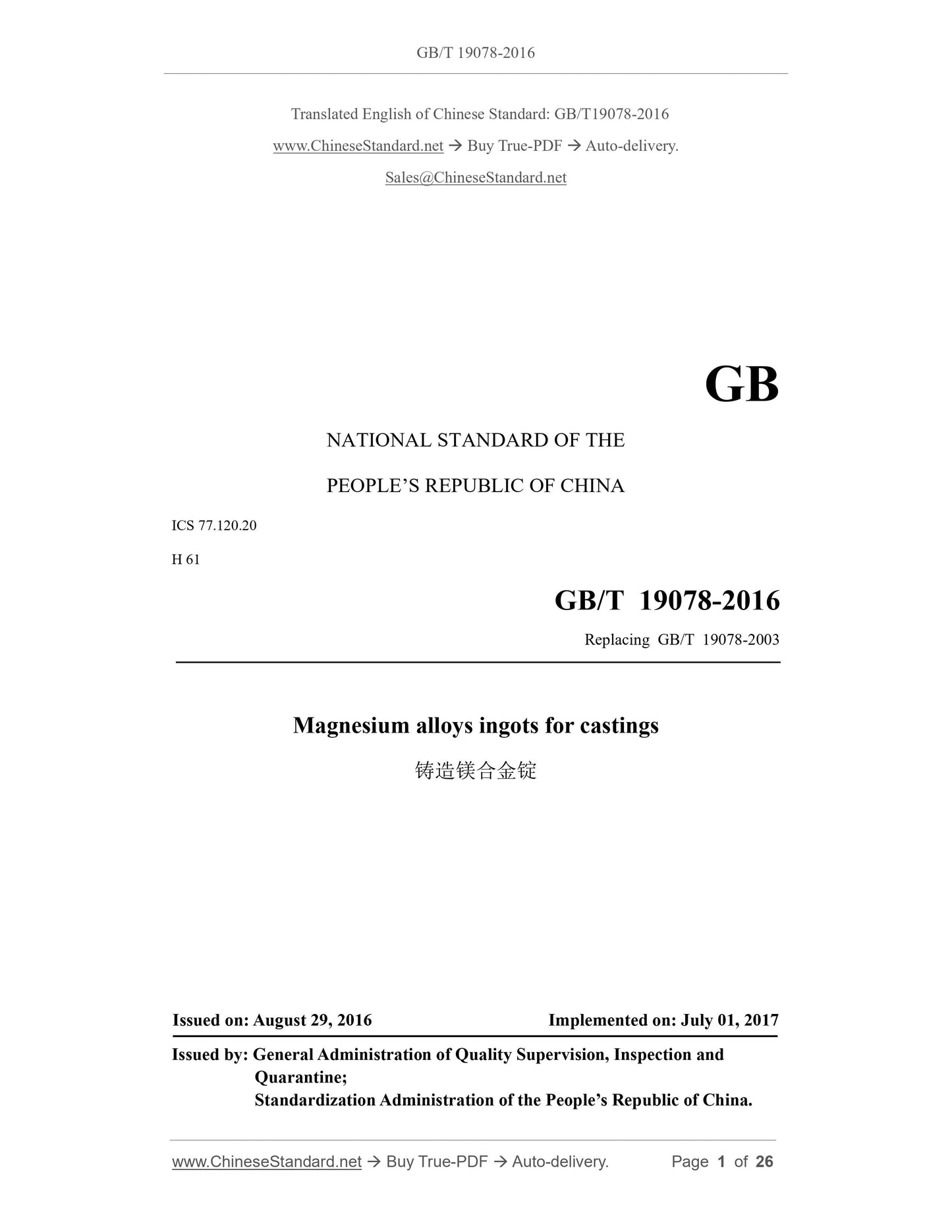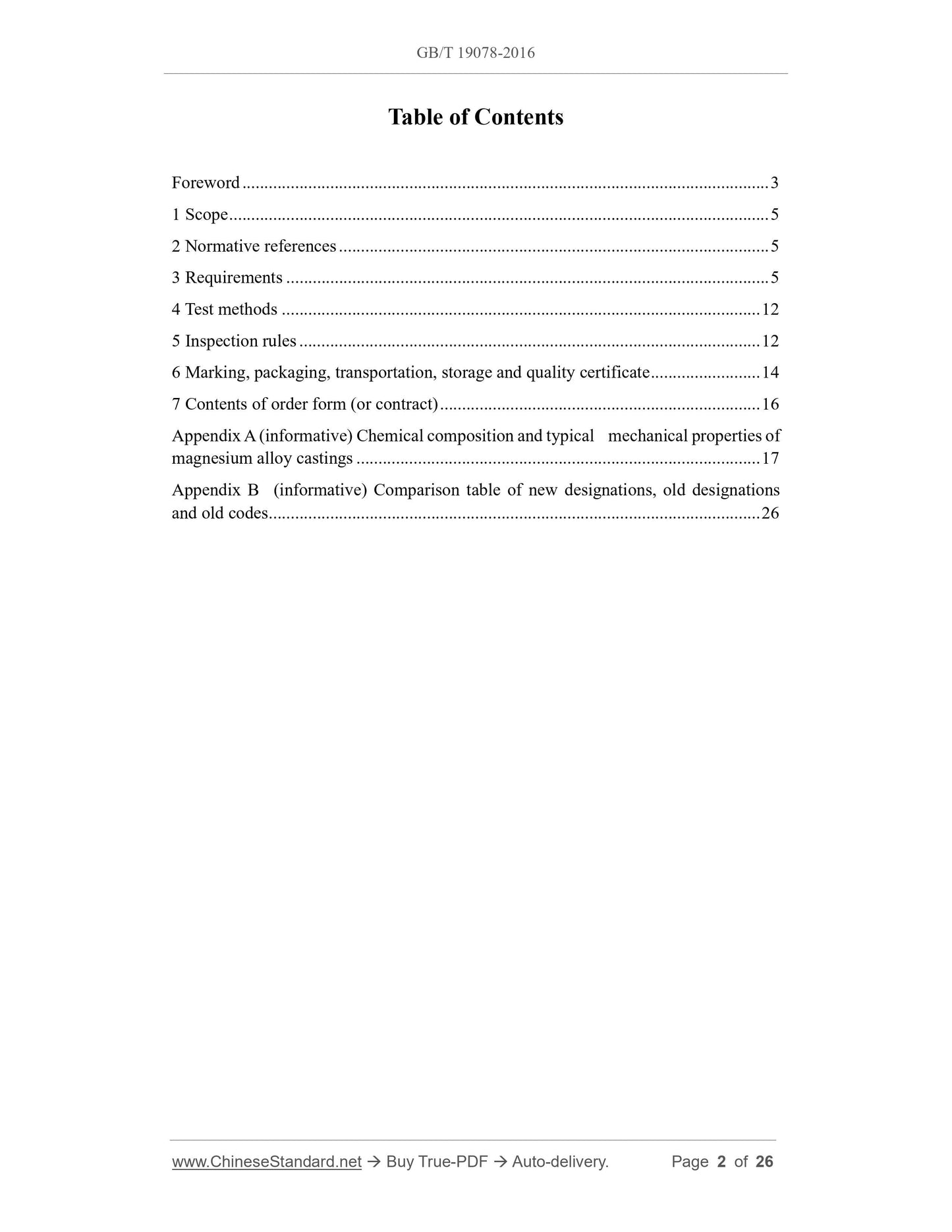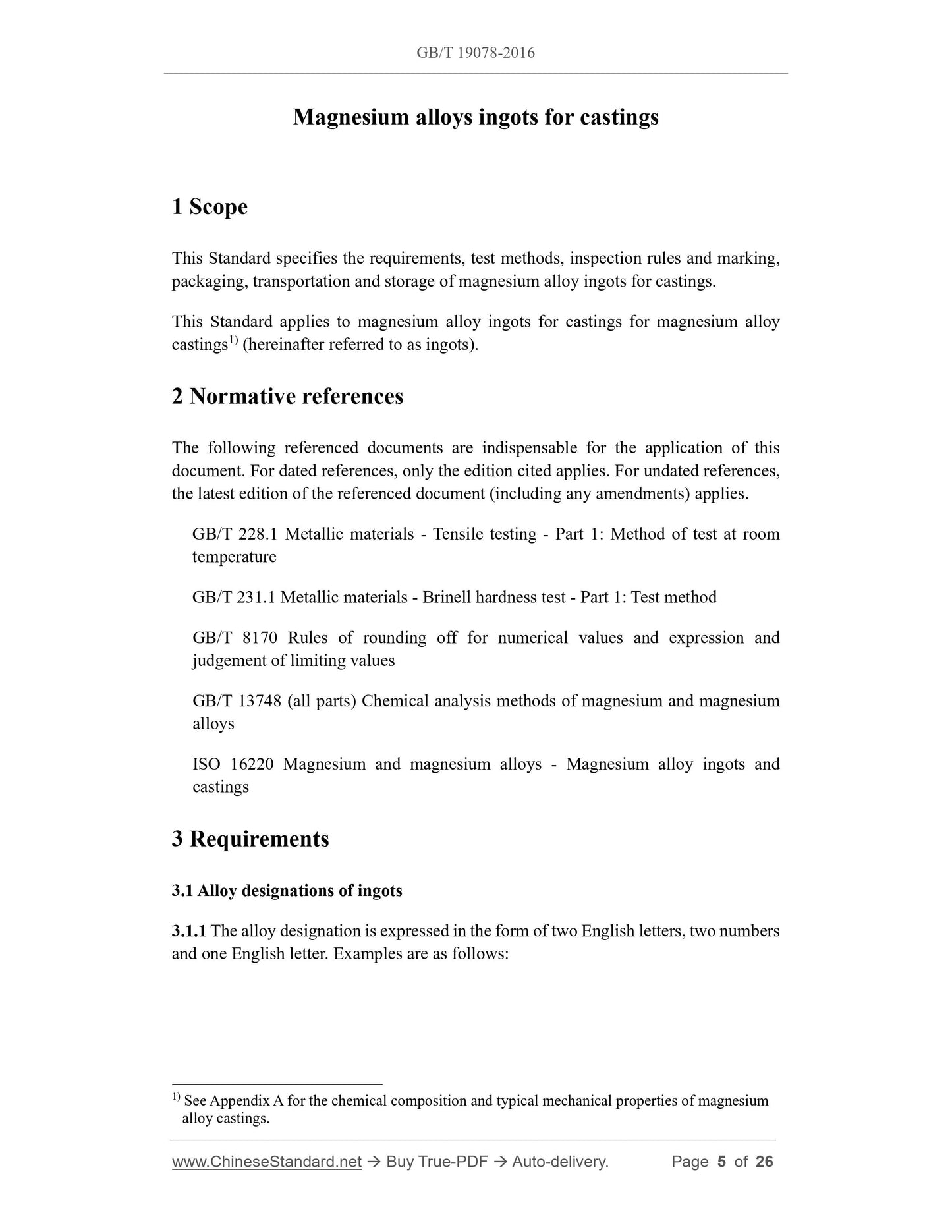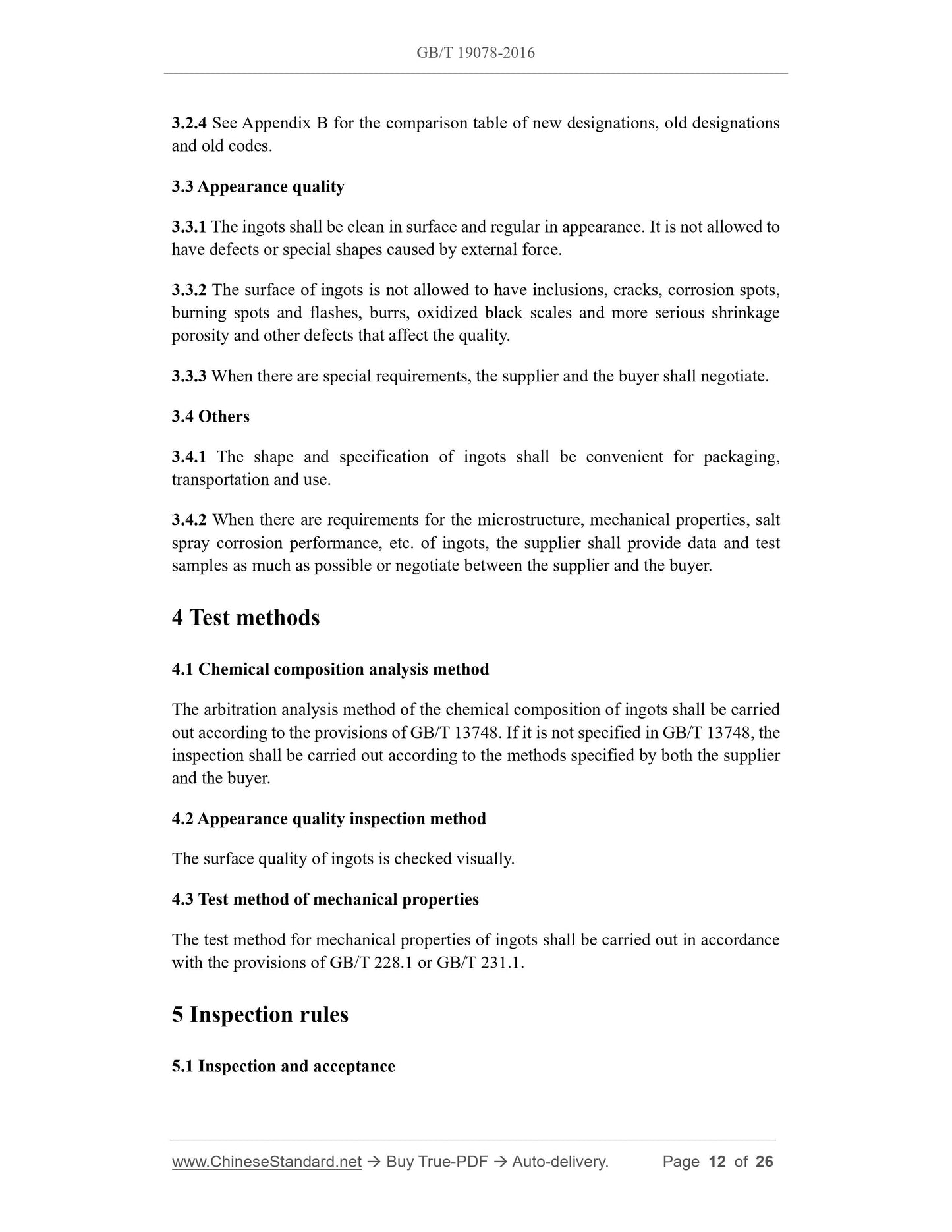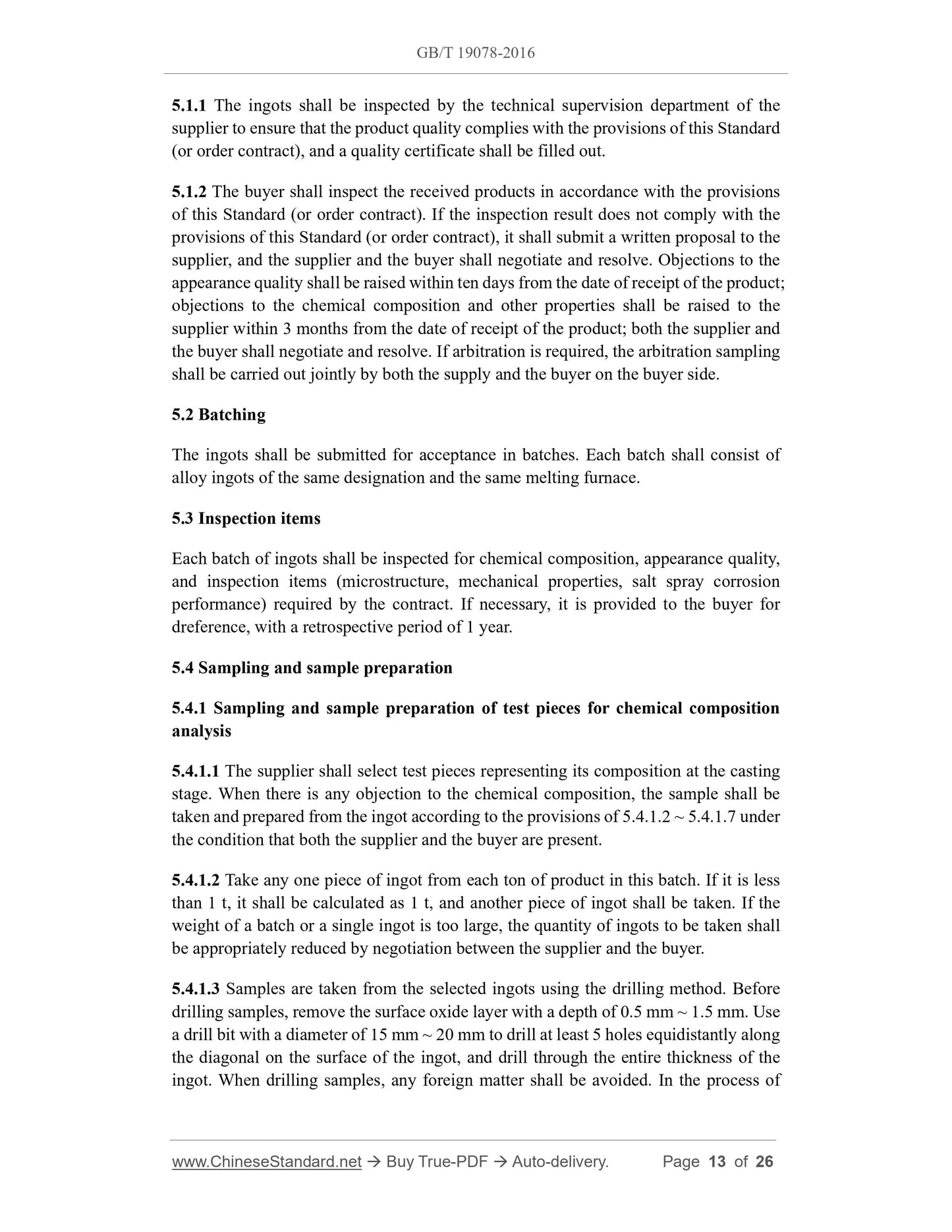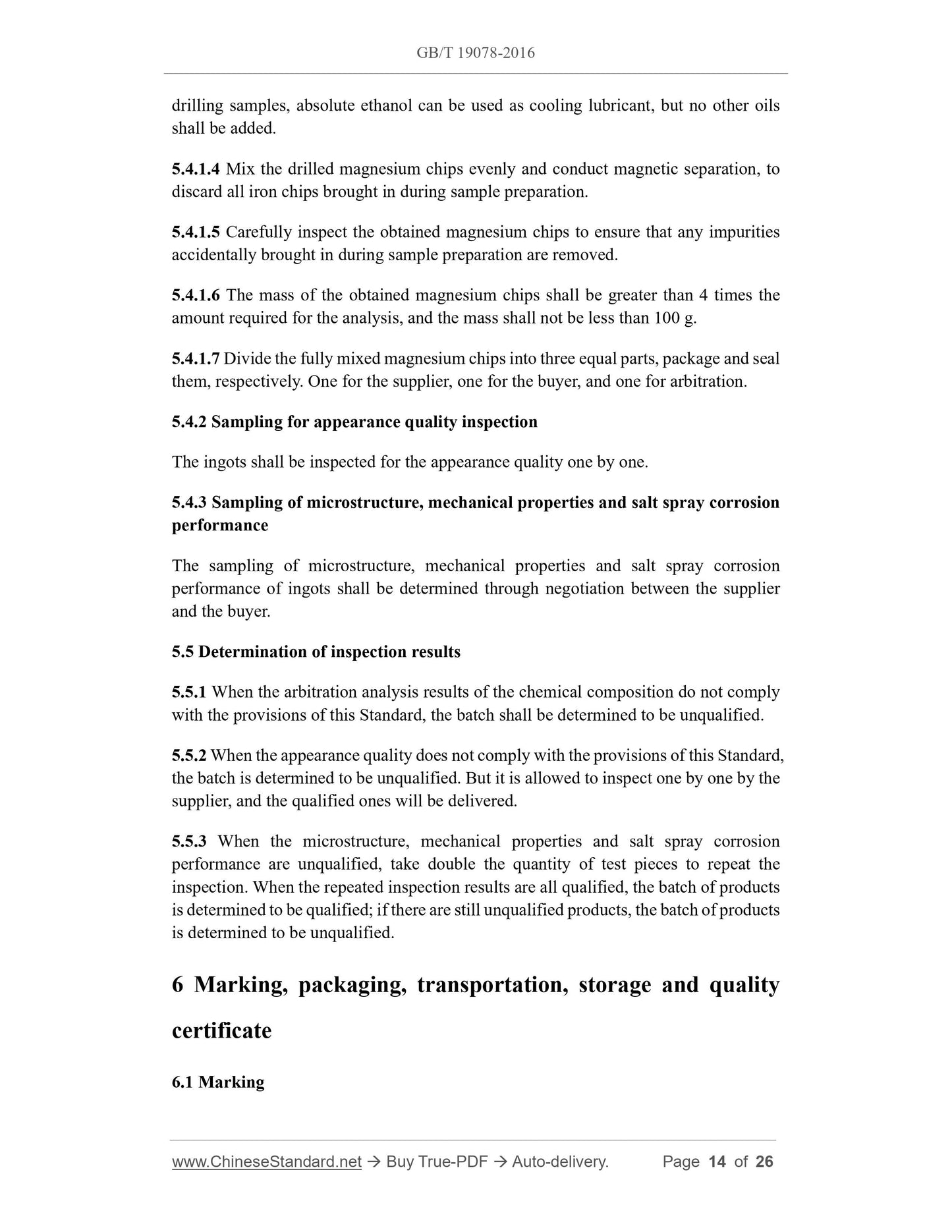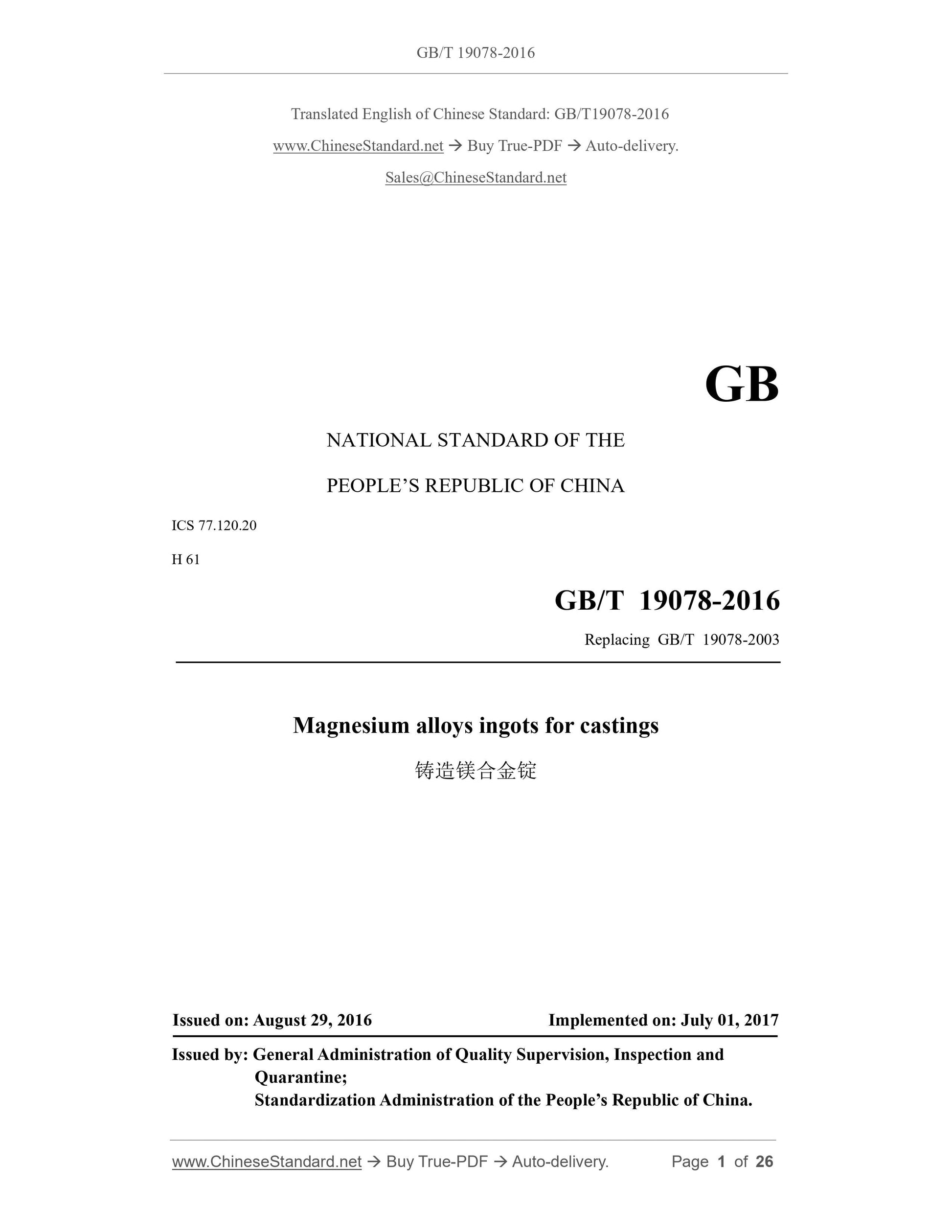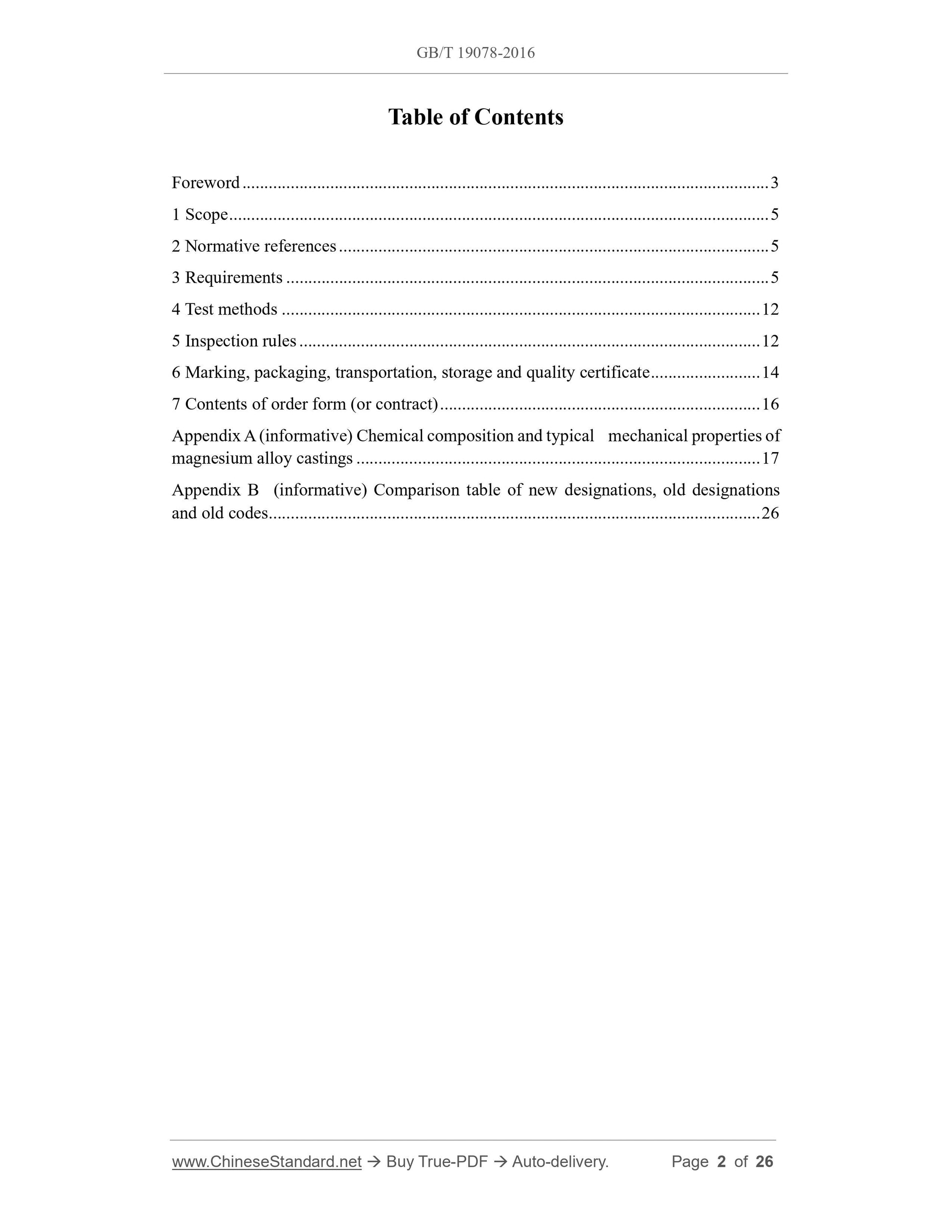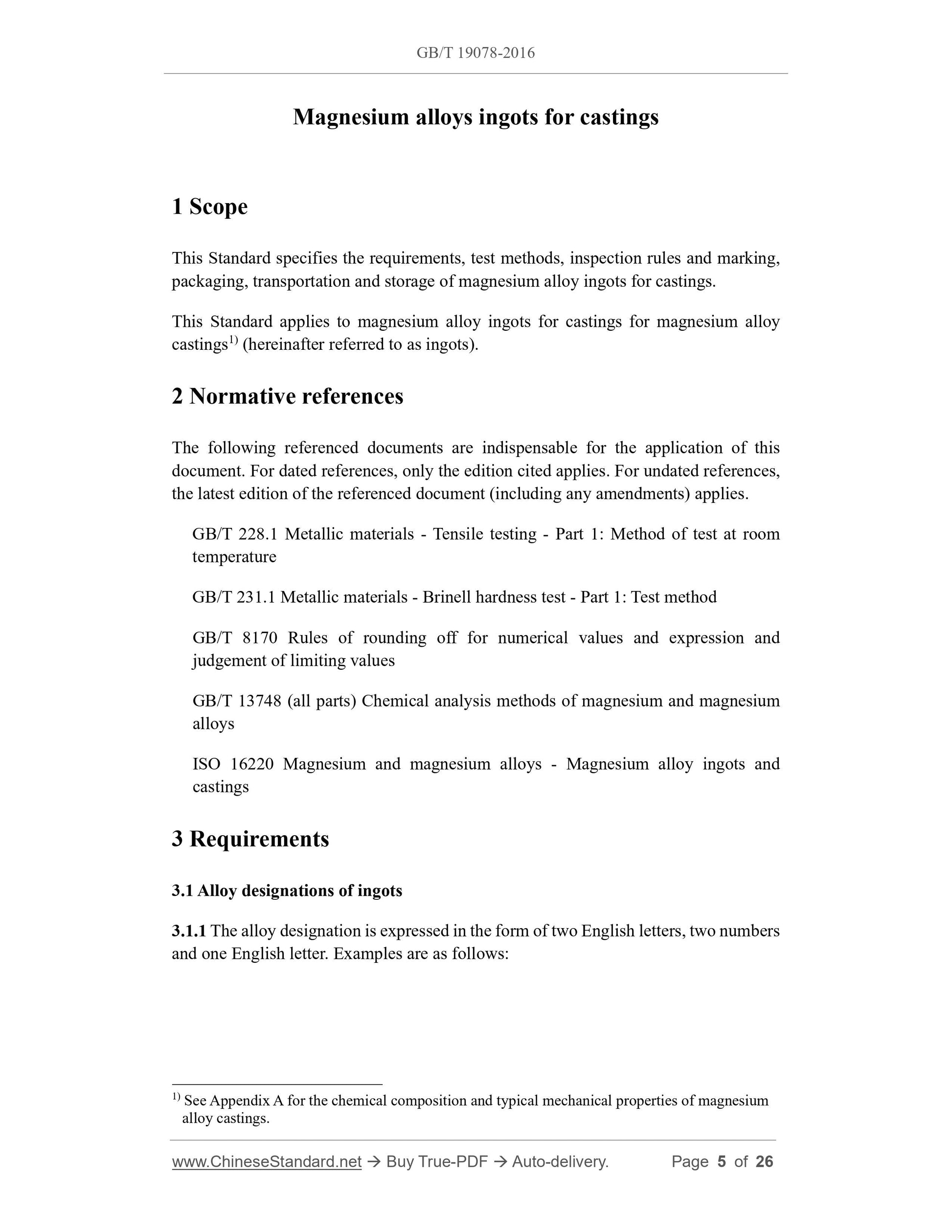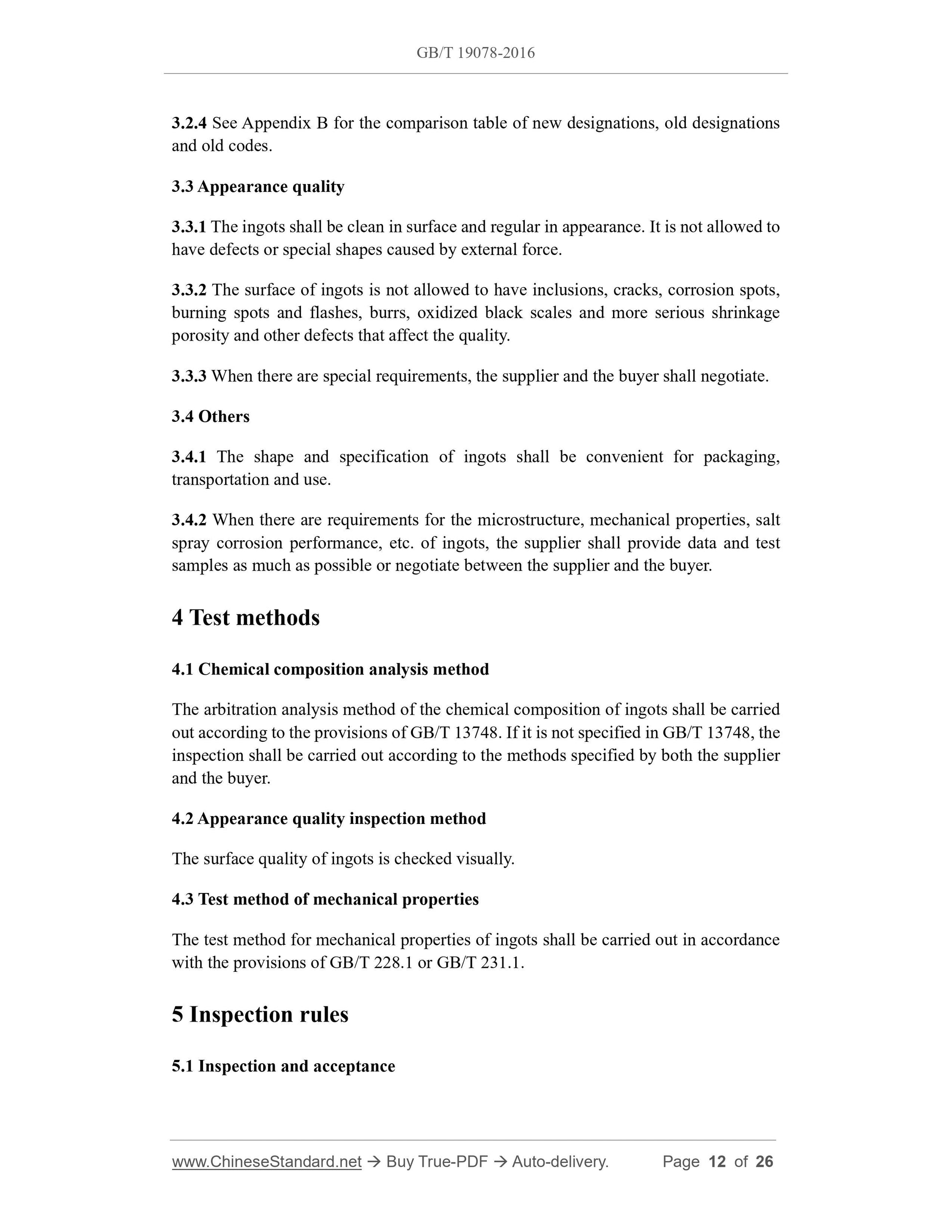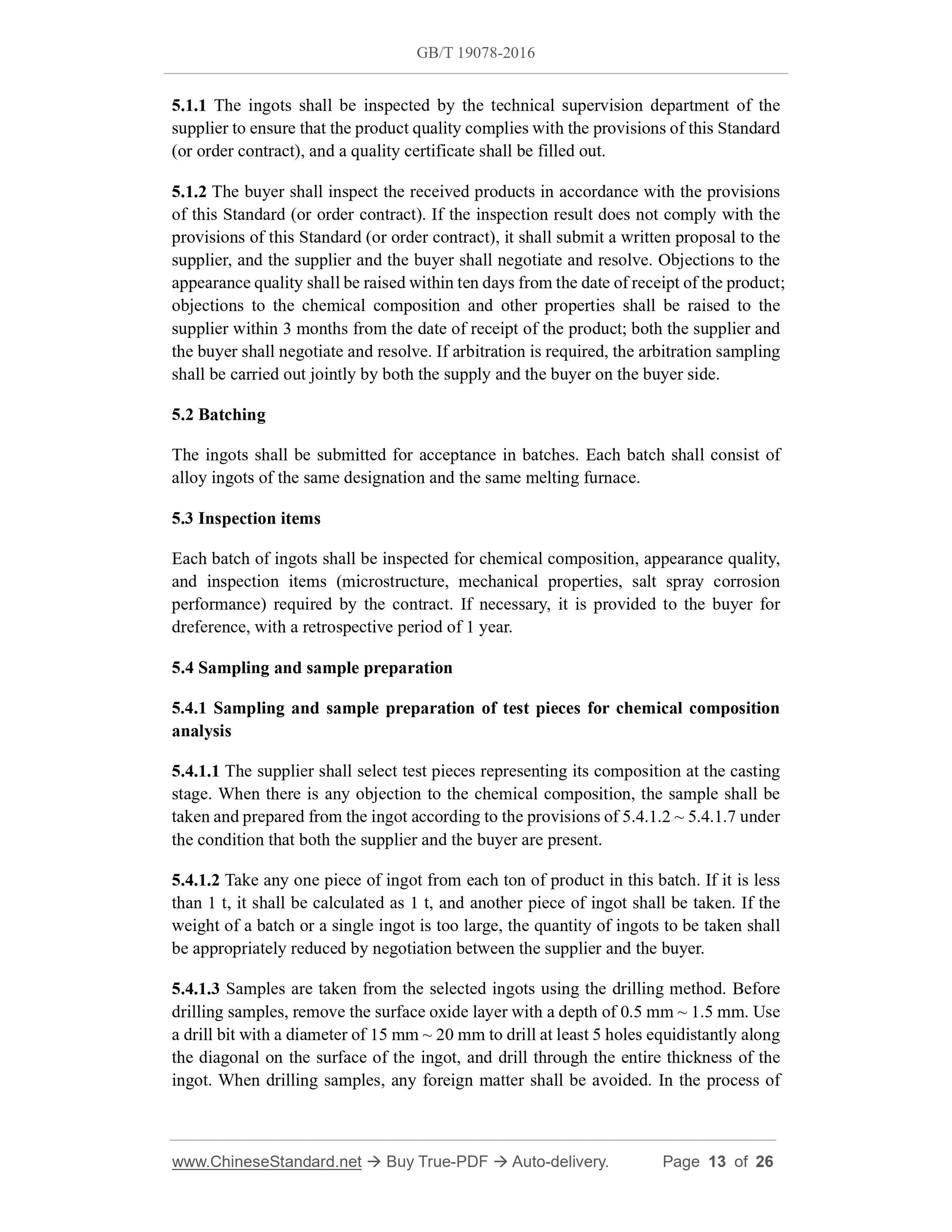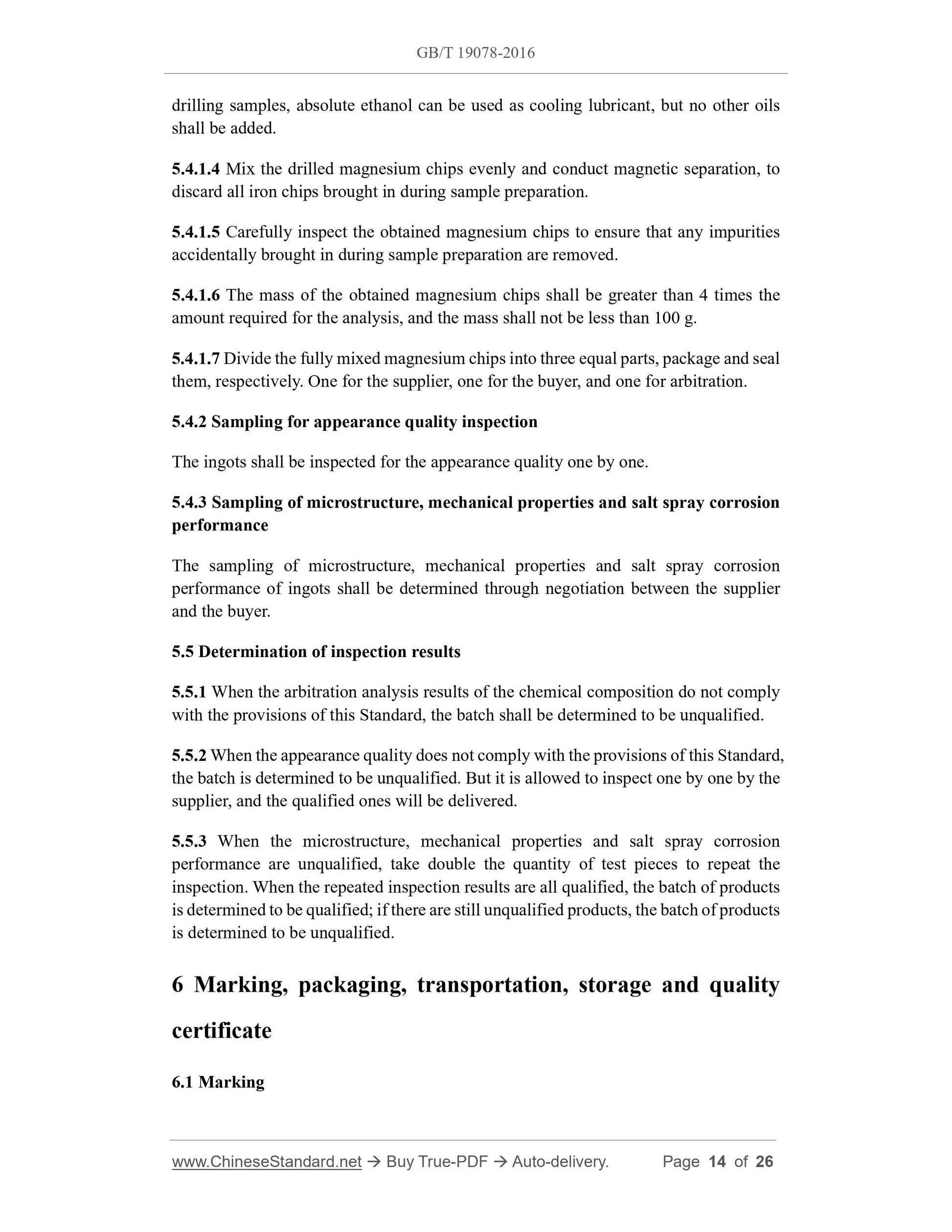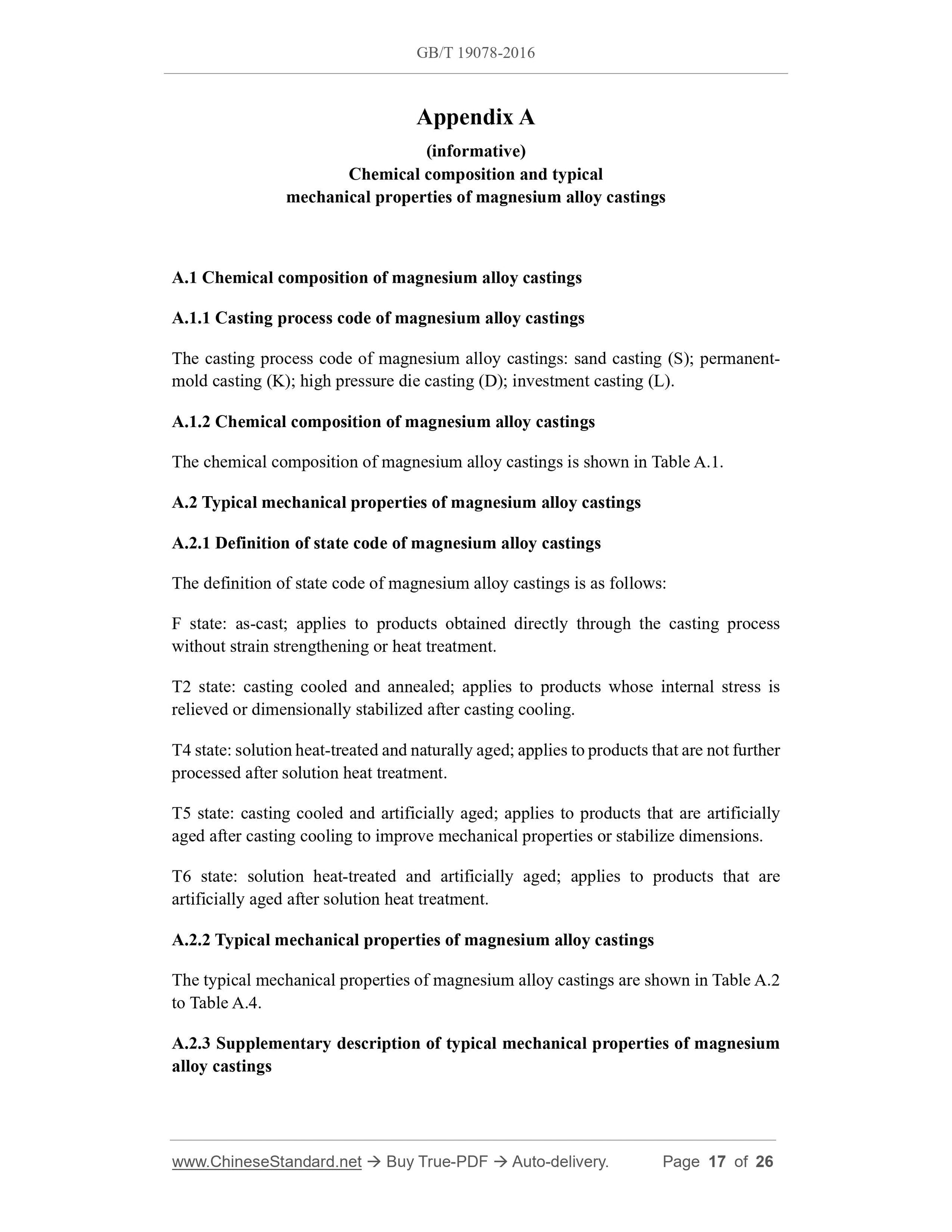1
/
of
7
www.ChineseStandard.us -- Field Test Asia Pte. Ltd.
GB/T 19078-2016 English PDF (GB/T19078-2016)
GB/T 19078-2016 English PDF (GB/T19078-2016)
Regular price
$375.00
Regular price
Sale price
$375.00
Unit price
/
per
Shipping calculated at checkout.
Couldn't load pickup availability
GB/T 19078-2016: Magnesium alloys ingots for castings
Delivery: 9 seconds. Download (& Email) true-PDF + Invoice.
Get Quotation: Click GB/T 19078-2016 (Self-service in 1-minute)
Historical versions (Master-website): GB/T 19078-2016
Preview True-PDF (Reload/Scroll-down if blank)
GB/T 19078-2016
GB
NATIONAL STANDARD OF THE
PEOPLE’S REPUBLIC OF CHINA
ICS 77.120.20
H 61
Replacing GB/T 19078-2003
Magnesium alloys ingots for castings
ISSUED ON: AUGUST 29, 2016
IMPLEMENTED ON: JULY 01, 2017
Issued by: General Administration of Quality Supervision, Inspection and
Quarantine;
Standardization Administration of the People’s Republic of China.
Table of Contents
Foreword ... 3
1 Scope ... 5
2 Normative references ... 5
3 Requirements ... 5
4 Test methods ... 12
5 Inspection rules ... 12
6 Marking, packaging, transportation, storage and quality certificate ... 14
7 Contents of order form (or contract) ... 16
Appendix A (informative) Chemical composition and typical mechanical properties of
magnesium alloy castings ... 17
Appendix B (informative) Comparison table of new designations, old designations
and old codes ... 26
Magnesium alloys ingots for castings
1 Scope
This Standard specifies the requirements, test methods, inspection rules and marking,
packaging, transportation and storage of magnesium alloy ingots for castings.
This Standard applies to magnesium alloy ingots for castings for magnesium alloy
castings1) (hereinafter referred to as ingots).
2 Normative references
The following referenced documents are indispensable for the application of this
document. For dated references, only the edition cited applies. For undated references,
the latest edition of the referenced document (including any amendments) applies.
GB/T 228.1 Metallic materials - Tensile testing - Part 1: Method of test at room
temperature
GB/T 231.1 Metallic materials - Brinell hardness test - Part 1: Test method
GB/T 8170 Rules of rounding off for numerical values and expression and
judgement of limiting values
GB/T 13748 (all parts) Chemical analysis methods of magnesium and magnesium
alloys
ISO 16220 Magnesium and magnesium alloys - Magnesium alloy ingots and
castings
3 Requirements
3.1 Alloy designations of ingots
3.1.1 The alloy designation is expressed in the form of two English letters, two numbers
and one English letter. Examples are as follows:
1) See Appendix A for the chemical composition and typical mechanical properties of magnesium
alloy castings.
3.2.4 See Appendix B for the comparison table of new designations, old designations
and old codes.
3.3 Appearance quality
3.3.1 The ingots shall be clean in surface and regular in appearance. It is not allowed to
have defects or special shapes caused by external force.
3.3.2 The surface of ingots is not allowed to have inclusions, cracks, corrosion spots,
burning spots and flashes, burrs, oxidized black scales and more serious shrinkage
porosity and other defects that affect the quality.
3.3.3 When there are special requirements, the supplier and the buyer shall negotiate.
3.4 Others
3.4.1 The shape and specification of ingots shall be convenient for packaging,
transportation and use.
3.4.2 When there are requirements for the microstructure, mechanical properties, salt
spray corrosion performance, etc. of ingots, the supplier shall provide data and test
samples as much as possible or negotiate between the supplier and the buyer.
4 Test methods
4.1 Chemical composition analysis method
The arbitration analysis method of the chemical composition of ingots shall be carried
out according to the provisions of GB/T 13748. If it is not specified in GB/T 13748, the
inspection shall be carried out according to the methods specified by both the supplier
and the buyer.
4.2 Appearance quality inspection method
The surface quality of ingots is checked visually.
4.3 Test method of mechanical properties
The test method for mechanical properties of ingots shall be carried out in accordance
with the provisions of GB/T 228.1 or GB/T 231.1.
5 Inspection rules
5.1 Inspection and acceptance
5.1.1 The ingots shall be inspected by the technical supervision department of the
supplier to ensure that the product quality complies with the provisions of this Standard
(or order contract), and a quality certificate shall be filled out.
5.1.2 The buyer shall inspect the received products in accordance with the provisions
of this Standard (or order contract). If the inspection result does not comply with the
provisions of this Standard (or order contract), it shall submit a written proposal to the
supplier, and the supplier and the buyer shall negotiate and resolve. Objections to the
appearance quality shall be raised within ten days from the date of receipt of the product;
objections to the chemical composition and other properties shall be raised to the
supplier within 3 months from the date of receipt of the product; both the supplier and
the buyer shall negotiate and resolve. If arbitration is required, the arbitration sampling
shall be carried out jointly by both the supply and the buyer on the buyer side.
5.2 Batching
The ingots shall be submitted for acceptance in batches. Each batch shall consist of
alloy ingots of the same designation and the same melting furnace.
5.3 Inspection items
Each batch of ingots shall be inspected for chemical composition, appearance quality,
and inspection items (microstructure, mechanical properties, salt spray corrosion
performance) required by the contract. If necessary, it is provided to the buyer for
dreference, with a retrospective period of 1 year.
5.4 Sampling and sample preparation
5.4.1 Sampling and sample preparation of test pieces for chemical composition
analysis
5.4.1.1 The supplier shall select test pieces representing its composition at the casting
stage. When there is any objection to the chemical composition, the sample shall be
taken and prepared from the ingot according to the provisions of 5.4.1.2 ~ 5.4.1.7 under
the condition that both the supplier and the buyer are present.
5.4.1.2 Take any one piece of ingot from each ton of product in this batch. If it is less
than 1 t, it shall be calculated as 1 t, and another piece of ingot shall be taken. If the
weight of a batch or a single ingot is too large, the quantity of ingots to be taken shall
be appropriately reduced by negotiation between the supplier and the buyer.
5.4.1.3 Samples are taken from the selected ingots using the drilling method. Before
drilling samples, remove the surface oxide layer with a depth of 0.5 mm ~ 1.5 mm. Use
a drill bit with a diameter of 15 mm ~ 20 mm to drill at least 5 holes equidistantly along
the diagonal on the surface of the ingot, and drill through the entire thickness of the
ingot. When drilling samples, any foreign matter shall be avoided. In the process of
drilling samples, absolute ethanol can be used as cooling lubricant, but no other oils
shall be added.
5.4.1.4 Mix the drilled magnesium chips evenly and conduct magnetic separation, to
discard all iron chips brought in during sample preparation.
5.4.1.5 Carefully inspect the obtained magnesium chips to ensure that any impurities
accidentally brought in during sample preparation are removed.
5.4.1.6 The mass of the obtained magnesium chips shall be greater than 4 times the
amount required for the analysis, and the mass shall not be less than 100 g.
5.4.1.7 Divide the fully mixed magnesium chips into three equal parts, package and seal
them, respectively. One for the supplier, one for the buyer, and one for arbitration.
5.4.2 Sampling for appearance quality inspection
The ingots shall be inspected for the appearance quality one by one.
5.4.3 Sampling of microstructure, mechanical properties and salt spray corrosion
performance
The sampling of microstructure, mechanical properties and salt spray corrosion
performance of ingots shall be determined through negotiation between the supplier
and the buyer.
5.5 Determination of inspection results
5.5.1 When the arbitration analysis results of the chemical composition do not comply
with the provisions of this Standard, the batch shall be determined to be unqualified.
5.5.2 When the appearance quality does not comply with the provisions of this Standard,
the batch is determined to be unqualified. But it is allowed to inspect one by one by the
supplier, and the qualified ones will be delivered.
5.5.3 When the microstructure, mechanical properties and salt spray corrosion
performance are unqualified, take double the quantity of test pieces to repeat the
inspection. When the repeated inspection results are all qualified, the batch of products
is determined to be qualified; if there are still unqualified products, the batch of products
is determined to be unqualified.
6 Marking, packaging, transportation, storage and quality
certificate
6.1 Marking
Appendix A
(informative)
Chemical composition and typical
mechanical properties of magnesium alloy castings
A.1 Chemical composition of magnesium alloy castings
A.1.1 Casting process code of magnesium alloy castings
The casting process code of magnesium alloy castings: sand casting (S); permanent-
mold casting (K); high pressure die casting (D); investment casting (L).
A.1.2 Chemical composition of magnesium alloy castings
The chemical composition of magnesium alloy castings is shown in Table A.1.
A.2 Typical mechanical properties of magnesium alloy castings
A.2.1 Definition of state code of magnesium alloy castings
The definition of state code of magnesium alloy castings is as follows:
F state: as-cast; applies to products obtained directly through the casting process
without strain strengthening or heat treatment.
T2 state: casting cooled and annealed; applies to products whose internal stress is
relieved or dimensionally stabilized after casting cooling.
T4 state: solution heat-treated and naturally aged; applies to products that are not further
processed after solution heat treatment.
T5 state: casting cooled and artificially aged; applies to products that are artificially
aged after casting cooling to improve mechanical properties or stabilize dimensions.
T6 state: solution heat-treated and artificially aged; applies to products that are
artificially aged after solution heat treatment.
A.2.2 Typical mechanical properties of magnesium alloy castings
The typical mechanical properties of magnesium alloy castings are shown in Table A.2
to Table A.4.
A.2.3 Supplementary description of typical mechanical properties of magnesium
alloy castings
GB/T 19078-2016
GB
NATIONAL STANDARD OF THE
PEOPLE’S REPUBLIC OF CHINA
ICS 77.120.20
H 61
Replacing GB/T 19078-2003
Magnesium alloys ingots for castings
ISSUED ON: AUGUST 29, 2016
IMPLEMENTED ON: JULY 01, 2017
Issued by: General Administration of Quality Supervision, Inspection and
Quarantine;
Standardization Administration of the People’s Republic of China.
Table of Contents
Foreword ... 3
1 Scope ... 5
2 Normative references ... 5
3 Requirements ... 5
4 Test methods ... 12
5 Inspection rules ... 12
6 Marking, packaging, transportation, storage and quality certificate ... 14
7 Contents of order form (or contract) ... 16
Appendix A (informative) Chemical composition and typical mechanical properties of
magnesium alloy castings ... 17
Appendix B (informative) Comparison table of new designations, old designations
and old codes ... 26
Magnesium alloys ingots for castings
1 Scope
This Standard specifies the requirements, test methods, inspection rules and marking,
packaging, transportation and storage of magnesium alloy ingots for castings.
This Standard applies to magnesium alloy ingots for castings for magnesium alloy
castings1) (hereinafter referred to as ingots).
2 Normative references
The following referenced documents are indispensable for the application of this
document. For dated references, only the edition cited applies. For undated references,
the latest edition of the referenced document (including any amendments) applies.
GB/T 228.1 Metallic materials - Tensile testing - Part 1: Method of test at room
temperature
GB/T 231.1 Metallic materials - Brinell hardness test - Part 1: Test method
GB/T 8170 Rules of rounding off for numerical values and expression and
judgement of limiting values
GB/T 13748 (all parts) Chemical analysis methods of magnesium and magnesium
alloys
ISO 16220 Magnesium and magnesium alloys - Magnesium alloy ingots and
castings
3 Requirements
3.1 Alloy designations of ingots
3.1.1 The alloy designation is expressed in the form of two English letters, two numbers
and one English letter. Examples are as follows:
1) See Appendix A for the chemical composition and typical mechanical properties of magnesium
alloy castings.
3.2.4 See Appendix B for the comparison table of new designations, old designations
and old codes.
3.3 Appearance quality
3.3.1 The ingots shall be clean in surface and regular in appearance. It is not allowed to
have defects or special shapes caused by external force.
3.3.2 The surface of ingots is not allowed to have inclusions, cracks, corrosion spots,
burning spots and flashes, burrs, oxidized black scales and more serious shrinkage
porosity and other defects that affect the quality.
3.3.3 When there are special requirements, the supplier and the buyer shall negotiate.
3.4 Others
3.4.1 The shape and specification of ingots shall be convenient for packaging,
transportation and use.
3.4.2 When there are requirements for the microstructure, mechanical properties, salt
spray corrosion performance, etc. of ingots, the supplier shall provide data and test
samples as much as possible or negotiate between the supplier and the buyer.
4 Test methods
4.1 Chemical composition analysis method
The arbitration analysis method of the chemical composition of ingots shall be carried
out according to the provisions of GB/T 13748. If it is not specified in GB/T 13748, the
inspection shall be carried out according to the methods specified by both the supplier
and the buyer.
4.2 Appearance quality inspection method
The surface quali...
Delivery: 9 seconds. Download (& Email) true-PDF + Invoice.
Get Quotation: Click GB/T 19078-2016 (Self-service in 1-minute)
Historical versions (Master-website): GB/T 19078-2016
Preview True-PDF (Reload/Scroll-down if blank)
GB/T 19078-2016
GB
NATIONAL STANDARD OF THE
PEOPLE’S REPUBLIC OF CHINA
ICS 77.120.20
H 61
Replacing GB/T 19078-2003
Magnesium alloys ingots for castings
ISSUED ON: AUGUST 29, 2016
IMPLEMENTED ON: JULY 01, 2017
Issued by: General Administration of Quality Supervision, Inspection and
Quarantine;
Standardization Administration of the People’s Republic of China.
Table of Contents
Foreword ... 3
1 Scope ... 5
2 Normative references ... 5
3 Requirements ... 5
4 Test methods ... 12
5 Inspection rules ... 12
6 Marking, packaging, transportation, storage and quality certificate ... 14
7 Contents of order form (or contract) ... 16
Appendix A (informative) Chemical composition and typical mechanical properties of
magnesium alloy castings ... 17
Appendix B (informative) Comparison table of new designations, old designations
and old codes ... 26
Magnesium alloys ingots for castings
1 Scope
This Standard specifies the requirements, test methods, inspection rules and marking,
packaging, transportation and storage of magnesium alloy ingots for castings.
This Standard applies to magnesium alloy ingots for castings for magnesium alloy
castings1) (hereinafter referred to as ingots).
2 Normative references
The following referenced documents are indispensable for the application of this
document. For dated references, only the edition cited applies. For undated references,
the latest edition of the referenced document (including any amendments) applies.
GB/T 228.1 Metallic materials - Tensile testing - Part 1: Method of test at room
temperature
GB/T 231.1 Metallic materials - Brinell hardness test - Part 1: Test method
GB/T 8170 Rules of rounding off for numerical values and expression and
judgement of limiting values
GB/T 13748 (all parts) Chemical analysis methods of magnesium and magnesium
alloys
ISO 16220 Magnesium and magnesium alloys - Magnesium alloy ingots and
castings
3 Requirements
3.1 Alloy designations of ingots
3.1.1 The alloy designation is expressed in the form of two English letters, two numbers
and one English letter. Examples are as follows:
1) See Appendix A for the chemical composition and typical mechanical properties of magnesium
alloy castings.
3.2.4 See Appendix B for the comparison table of new designations, old designations
and old codes.
3.3 Appearance quality
3.3.1 The ingots shall be clean in surface and regular in appearance. It is not allowed to
have defects or special shapes caused by external force.
3.3.2 The surface of ingots is not allowed to have inclusions, cracks, corrosion spots,
burning spots and flashes, burrs, oxidized black scales and more serious shrinkage
porosity and other defects that affect the quality.
3.3.3 When there are special requirements, the supplier and the buyer shall negotiate.
3.4 Others
3.4.1 The shape and specification of ingots shall be convenient for packaging,
transportation and use.
3.4.2 When there are requirements for the microstructure, mechanical properties, salt
spray corrosion performance, etc. of ingots, the supplier shall provide data and test
samples as much as possible or negotiate between the supplier and the buyer.
4 Test methods
4.1 Chemical composition analysis method
The arbitration analysis method of the chemical composition of ingots shall be carried
out according to the provisions of GB/T 13748. If it is not specified in GB/T 13748, the
inspection shall be carried out according to the methods specified by both the supplier
and the buyer.
4.2 Appearance quality inspection method
The surface quality of ingots is checked visually.
4.3 Test method of mechanical properties
The test method for mechanical properties of ingots shall be carried out in accordance
with the provisions of GB/T 228.1 or GB/T 231.1.
5 Inspection rules
5.1 Inspection and acceptance
5.1.1 The ingots shall be inspected by the technical supervision department of the
supplier to ensure that the product quality complies with the provisions of this Standard
(or order contract), and a quality certificate shall be filled out.
5.1.2 The buyer shall inspect the received products in accordance with the provisions
of this Standard (or order contract). If the inspection result does not comply with the
provisions of this Standard (or order contract), it shall submit a written proposal to the
supplier, and the supplier and the buyer shall negotiate and resolve. Objections to the
appearance quality shall be raised within ten days from the date of receipt of the product;
objections to the chemical composition and other properties shall be raised to the
supplier within 3 months from the date of receipt of the product; both the supplier and
the buyer shall negotiate and resolve. If arbitration is required, the arbitration sampling
shall be carried out jointly by both the supply and the buyer on the buyer side.
5.2 Batching
The ingots shall be submitted for acceptance in batches. Each batch shall consist of
alloy ingots of the same designation and the same melting furnace.
5.3 Inspection items
Each batch of ingots shall be inspected for chemical composition, appearance quality,
and inspection items (microstructure, mechanical properties, salt spray corrosion
performance) required by the contract. If necessary, it is provided to the buyer for
dreference, with a retrospective period of 1 year.
5.4 Sampling and sample preparation
5.4.1 Sampling and sample preparation of test pieces for chemical composition
analysis
5.4.1.1 The supplier shall select test pieces representing its composition at the casting
stage. When there is any objection to the chemical composition, the sample shall be
taken and prepared from the ingot according to the provisions of 5.4.1.2 ~ 5.4.1.7 under
the condition that both the supplier and the buyer are present.
5.4.1.2 Take any one piece of ingot from each ton of product in this batch. If it is less
than 1 t, it shall be calculated as 1 t, and another piece of ingot shall be taken. If the
weight of a batch or a single ingot is too large, the quantity of ingots to be taken shall
be appropriately reduced by negotiation between the supplier and the buyer.
5.4.1.3 Samples are taken from the selected ingots using the drilling method. Before
drilling samples, remove the surface oxide layer with a depth of 0.5 mm ~ 1.5 mm. Use
a drill bit with a diameter of 15 mm ~ 20 mm to drill at least 5 holes equidistantly along
the diagonal on the surface of the ingot, and drill through the entire thickness of the
ingot. When drilling samples, any foreign matter shall be avoided. In the process of
drilling samples, absolute ethanol can be used as cooling lubricant, but no other oils
shall be added.
5.4.1.4 Mix the drilled magnesium chips evenly and conduct magnetic separation, to
discard all iron chips brought in during sample preparation.
5.4.1.5 Carefully inspect the obtained magnesium chips to ensure that any impurities
accidentally brought in during sample preparation are removed.
5.4.1.6 The mass of the obtained magnesium chips shall be greater than 4 times the
amount required for the analysis, and the mass shall not be less than 100 g.
5.4.1.7 Divide the fully mixed magnesium chips into three equal parts, package and seal
them, respectively. One for the supplier, one for the buyer, and one for arbitration.
5.4.2 Sampling for appearance quality inspection
The ingots shall be inspected for the appearance quality one by one.
5.4.3 Sampling of microstructure, mechanical properties and salt spray corrosion
performance
The sampling of microstructure, mechanical properties and salt spray corrosion
performance of ingots shall be determined through negotiation between the supplier
and the buyer.
5.5 Determination of inspection results
5.5.1 When the arbitration analysis results of the chemical composition do not comply
with the provisions of this Standard, the batch shall be determined to be unqualified.
5.5.2 When the appearance quality does not comply with the provisions of this Standard,
the batch is determined to be unqualified. But it is allowed to inspect one by one by the
supplier, and the qualified ones will be delivered.
5.5.3 When the microstructure, mechanical properties and salt spray corrosion
performance are unqualified, take double the quantity of test pieces to repeat the
inspection. When the repeated inspection results are all qualified, the batch of products
is determined to be qualified; if there are still unqualified products, the batch of products
is determined to be unqualified.
6 Marking, packaging, transportation, storage and quality
certificate
6.1 Marking
Appendix A
(informative)
Chemical composition and typical
mechanical properties of magnesium alloy castings
A.1 Chemical composition of magnesium alloy castings
A.1.1 Casting process code of magnesium alloy castings
The casting process code of magnesium alloy castings: sand casting (S); permanent-
mold casting (K); high pressure die casting (D); investment casting (L).
A.1.2 Chemical composition of magnesium alloy castings
The chemical composition of magnesium alloy castings is shown in Table A.1.
A.2 Typical mechanical properties of magnesium alloy castings
A.2.1 Definition of state code of magnesium alloy castings
The definition of state code of magnesium alloy castings is as follows:
F state: as-cast; applies to products obtained directly through the casting process
without strain strengthening or heat treatment.
T2 state: casting cooled and annealed; applies to products whose internal stress is
relieved or dimensionally stabilized after casting cooling.
T4 state: solution heat-treated and naturally aged; applies to products that are not further
processed after solution heat treatment.
T5 state: casting cooled and artificially aged; applies to products that are artificially
aged after casting cooling to improve mechanical properties or stabilize dimensions.
T6 state: solution heat-treated and artificially aged; applies to products that are
artificially aged after solution heat treatment.
A.2.2 Typical mechanical properties of magnesium alloy castings
The typical mechanical properties of magnesium alloy castings are shown in Table A.2
to Table A.4.
A.2.3 Supplementary description of typical mechanical properties of magnesium
alloy castings
GB/T 19078-2016
GB
NATIONAL STANDARD OF THE
PEOPLE’S REPUBLIC OF CHINA
ICS 77.120.20
H 61
Replacing GB/T 19078-2003
Magnesium alloys ingots for castings
ISSUED ON: AUGUST 29, 2016
IMPLEMENTED ON: JULY 01, 2017
Issued by: General Administration of Quality Supervision, Inspection and
Quarantine;
Standardization Administration of the People’s Republic of China.
Table of Contents
Foreword ... 3
1 Scope ... 5
2 Normative references ... 5
3 Requirements ... 5
4 Test methods ... 12
5 Inspection rules ... 12
6 Marking, packaging, transportation, storage and quality certificate ... 14
7 Contents of order form (or contract) ... 16
Appendix A (informative) Chemical composition and typical mechanical properties of
magnesium alloy castings ... 17
Appendix B (informative) Comparison table of new designations, old designations
and old codes ... 26
Magnesium alloys ingots for castings
1 Scope
This Standard specifies the requirements, test methods, inspection rules and marking,
packaging, transportation and storage of magnesium alloy ingots for castings.
This Standard applies to magnesium alloy ingots for castings for magnesium alloy
castings1) (hereinafter referred to as ingots).
2 Normative references
The following referenced documents are indispensable for the application of this
document. For dated references, only the edition cited applies. For undated references,
the latest edition of the referenced document (including any amendments) applies.
GB/T 228.1 Metallic materials - Tensile testing - Part 1: Method of test at room
temperature
GB/T 231.1 Metallic materials - Brinell hardness test - Part 1: Test method
GB/T 8170 Rules of rounding off for numerical values and expression and
judgement of limiting values
GB/T 13748 (all parts) Chemical analysis methods of magnesium and magnesium
alloys
ISO 16220 Magnesium and magnesium alloys - Magnesium alloy ingots and
castings
3 Requirements
3.1 Alloy designations of ingots
3.1.1 The alloy designation is expressed in the form of two English letters, two numbers
and one English letter. Examples are as follows:
1) See Appendix A for the chemical composition and typical mechanical properties of magnesium
alloy castings.
3.2.4 See Appendix B for the comparison table of new designations, old designations
and old codes.
3.3 Appearance quality
3.3.1 The ingots shall be clean in surface and regular in appearance. It is not allowed to
have defects or special shapes caused by external force.
3.3.2 The surface of ingots is not allowed to have inclusions, cracks, corrosion spots,
burning spots and flashes, burrs, oxidized black scales and more serious shrinkage
porosity and other defects that affect the quality.
3.3.3 When there are special requirements, the supplier and the buyer shall negotiate.
3.4 Others
3.4.1 The shape and specification of ingots shall be convenient for packaging,
transportation and use.
3.4.2 When there are requirements for the microstructure, mechanical properties, salt
spray corrosion performance, etc. of ingots, the supplier shall provide data and test
samples as much as possible or negotiate between the supplier and the buyer.
4 Test methods
4.1 Chemical composition analysis method
The arbitration analysis method of the chemical composition of ingots shall be carried
out according to the provisions of GB/T 13748. If it is not specified in GB/T 13748, the
inspection shall be carried out according to the methods specified by both the supplier
and the buyer.
4.2 Appearance quality inspection method
The surface quali...
Share
